Seaside Camps: Mingling of the Sexes
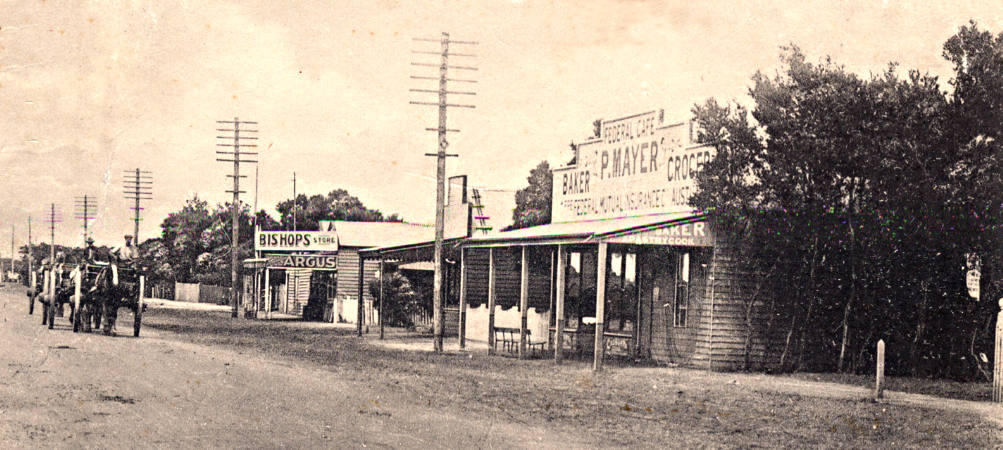
Shops on the main road at Chelsea, c1914.
Of late years there has been a harkening back to the simple life (says the Age). The cry has gone forth “why, with our climate, our summer’s heat, should we stay in our prim suburban homes? We have holidays; let us enjoy them as best we may. Let us take a tent and camp by the seashore. Then we can go as we choose.” But in the tail of the cry lies a sting, a danger. By all means live the simple life, if simple means natural; but simple does not mean primitive.
The idea of living by the seashore once mooted, grew quickly; it was put into actual practice. It was essential that the camps should be sufficient distance from the city to escape the ordinary Saturday and Sunday crowd. It must have a good railway service. Beyond Mordialloc, conditions were favourable, and the white peaked tents commenced to peep amongst the dense ti-tree. Just back from the road which skirts the shore from Frankston, Carrum, Aspendale back to Mordialloc, the tents were pitched, and each year the numbers have grown until during this Christmas and New Year holidays, hundreds of them are to be seen. With the demand for canvas dwellings there naturally sprung up a traffic in tents; far seeing residents bought large tents and pitched them on their small allotments. They hired them out furnished, at a weekly rental of from 15s to £1.
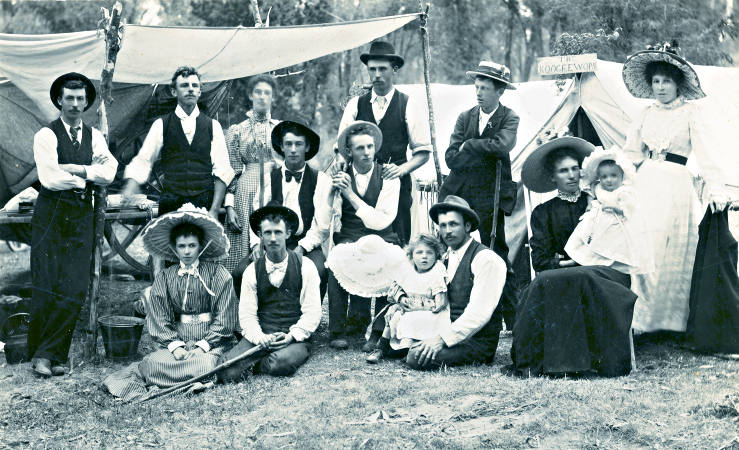
A group of women, men and some children camping in tents, c1900. Courtesy of the Moorabbin and District Historical Society.
First batches of young men inhabited the tents for holidays and week ends. Then their friends bought small blocks and brought more tents, and made regular weekend shanties, mostly of canvas. It was a delightful life of ease and go-as-you please. There was everything conducive to good health – plenty of fresh air, fresh and salt water and exercise, for during their more energetic moments the men built lattice fences. The campers banded together; they called themselves by grotesque names. On hot days and holidays and in vacation they divided their time between the water and the stretches. Their chief costume was many shades of Canadian bathing suits. Thus they receive their friends – other girls and youths. All went bathing together. Whole families began to take tiny houses or tents. They squashed inside or slept under trees. More tents were pitched. Young girls banded together and became campers for the holidays. Whole communities are established and lived huddled together in close proximity. Privacy became more slender, and still more slender, till today an unorthodox state of affairs exists which has “happened” rather than been designed. The hot blush of shame comes to no maiden’s cheek because at her tented door appears a dark skinned youth clothed in Canadians. She, too, has the same regulation garb, with, maybe a kimono to shield her “form divine.” The two make off for the water. Neither sex seems to bother about shoes or stockings, in fact, the men wear constantly their bathing costumes with towel or some small addition, while the short frocked girls leave throats, arms and legs bare. At first glance such communities remind the visitors of Utopia unlimited. Men occupy one tent, a band of girls the next. A little further along may be found a whole family. The tents are by no means comfortable, though from many come the sounds of laughter or the shrill tones of the gramophone. There are no floors only matted bracken laid on the sand. There are beds, a few stretchers, and a few upturned boxes. Some do not boast even of such appointments, the tent being merely a sheet of canvas supported on a pole without furnishings of any sort. The inmates sleep on the sand.
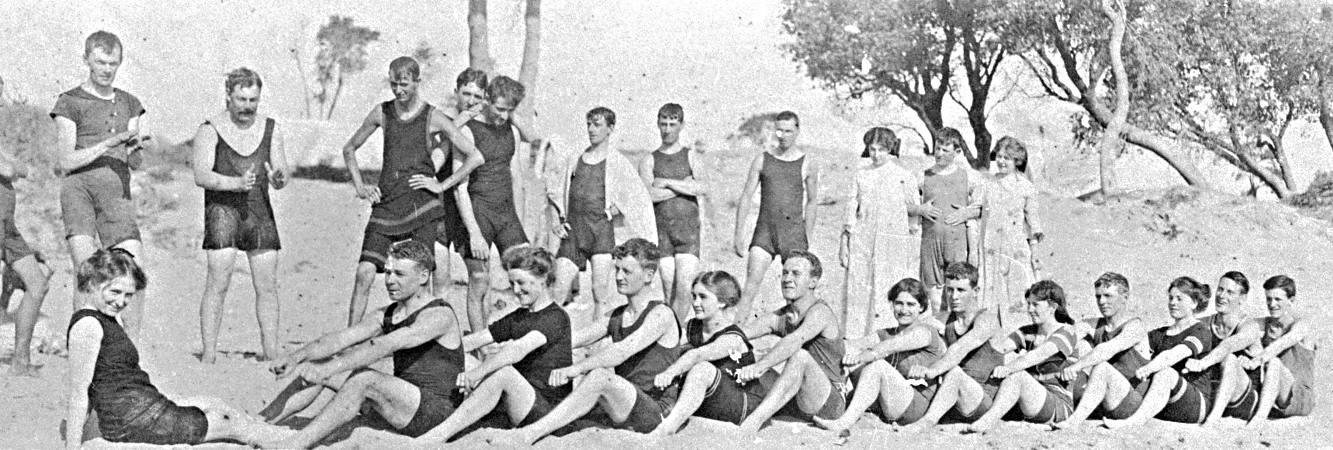
Bathing Group at Long Island Beach, 1911. Courtesy Leader Collection.
The natural question forms in the mind, and is put and answered by a young matron as she sits by an improvised cooker:-
“But are the girls alone in the camps?”
“Oh, they are all engaged to the men in the next tents. They come every holiday and each weekend.”
“Are all the girls in the camps along the coast engaged?”
‘Oh, no; there are some different camps, a bit disorderly. We kept things all right here, but some of the girls get a bit flighty.”
“What of the parents?”
“Oh, the parents do not know what goes on. They have never been down to see, so how would they? The girls go to ‘stay with friends,’ and that passes muster. I believe in letting them have their fling. They are all right.
But not to labor the question, the danger lurks. It is laughed at – by the campers, scorned.
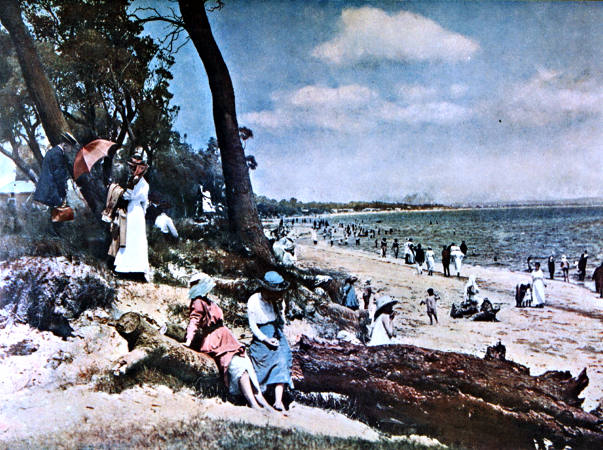
Aspendale Beach, South of Mordialloc Creek, c1900. Courtesy Kingston Collection.
Still there remains another side. There are gross cases of carelessness in essential details of health. Stale food is flung round to rot and decay; papers litter the ground; stale beer bottles tell their own tale. There is no great quantity of fresh water available, and sand blows in at every corner. Sanitary conditions are crude, and often offensive. That the Dandenong Shire Council as the responsible body, should step in and sort out the camps – for tent life in itself is healthy, enjoyable and for the holidays wise – and pass regulations to ensure safe sanitary conditions is urgently needed. The matter is one which should be taken in hand without delay, so that a pastime may not develop into a menace.
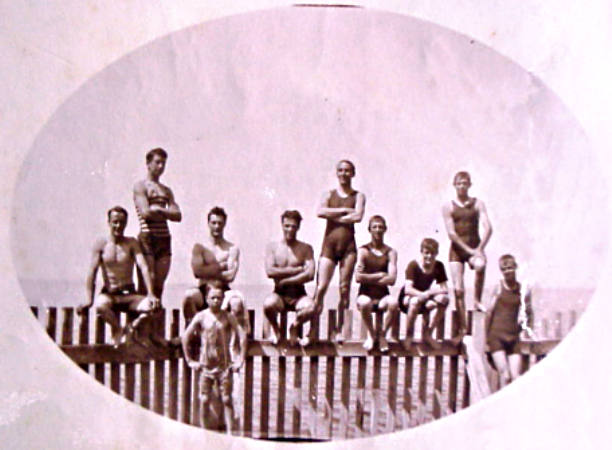
Men and boys in bathers sitting on fence. Courtesy Betty Kuc.
